Se Liga na Língua Inglesa – New Beyond Words
Elzimar Goettenauer, Luciana de Freitas, Rogério Neves
Código da Coleção: 0006 P24 01 00 200 090
Proposta pedagógica
- Facilitar a aproximação entre o estudante e a Língua Inglesa de forma gradativa, inserindo comandos na língua estrangeira aos poucos.
- Habituar o aluno a um segundo idioma, trabalhando com um processo similar à alfabetização.
- Trabalhar, junto ao letramento na Língua Inglesa, o repertório crítico do aluno, incentivando o posicionamento do mesmo sobre temas relevantes de sua realidade.
Código do Obra: 0006 P24 01 00 200 090

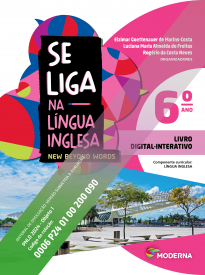
Código do Obra: 0006 P24 01 00 200 090

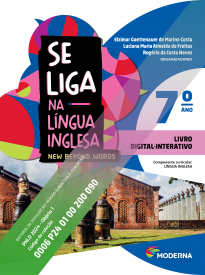
Código do Obra: 0006 P24 01 00 200 090

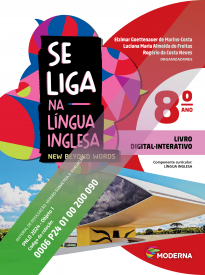
Código do Obra: 0006 P24 01 00 200 090

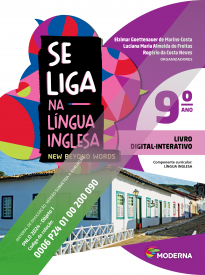
Comparativos estaduais
Selecione o seu estado e veja como nossas obras cumprem o currículo estadual
Conteúdo programático
Starting point – p. 10
1 – Who are you? – p. 20
Gêneros discursivos: documento pessoal e apresentação pessoal escrita e oral.
Tema: identidade e cidadania.
Time to think – p. 22
Reading – p. 23
Task 1 (personal document) – p. 23
- Before reading – p. 23
- Read to learn – p. 24
- Constructing meanings – p. 25
Task 2 (personal document) – p. 25
- Before reading – p. 25
- Read to learn – p. 26
- Constructing meanings – p. 28
Task 3 (written personal presentation) – p. 28
- Before reading – p. 28
- Read to learn – p. 29
- Constructing meanings – p. 29
Think a little more – p. 30
Listening – p. 30
- Before listening – p. 30
- Listen to learn – p. 31
- Constructing meanings – p. 31
Think a little more – p. 32
Language in action – p. 32
Speaking – p. 34
- Hit the road – p. 34
- Toolbox – p. 35
- Step back – p. 35
Pit stop – p. 35
Think it over – p. 36
Eyes on grammar – p. 36
- Personal information – p. 36
- Getting to know each other – p. 36
- Subject pronouns – p. 37
- Subject pronouns + verb to be (present simple) – p. 37
- Numbers – p. 37
2 – English everywhere – p. 38
Gêneros discursivos: tirinha, verbete de dicionário e vídeo informativo.
Tema: a presença e o uso do inglês no dia a dia do Brasil.
Time to think – p. 40
Reading – p. 41
Task 1 (comic strip) – p. 41
- Before reading – p. 41
- Read to learn – p. 41
- Constructing meanings – p. 42
Task 2 (dictionary entry) – p. 43
- Before reading – p. 43
- Read to learn – p. 43
- Constructing meanings – p. 44
Task 3 (dictionary entry) – p. 44
- Before reading – p. 44
- Read to learn – p. 44
- Constructing meanings – p. 45
Think a little more – p. 45
Listening – p. 46
- Before listening – p. 46
- Listen to learn – p. 46
- Constructing meanings – p. 46
Think a little more – p. 47
Language in action – p. 47
Writing – p. 50
- Hit the road – p. 50
- Toolbox – p. 51
- Step back – p. 51
Pit stop – p. 51
Think it over – p. 52
Eyes on grammar – p. 52
- Indefinite articles – p. 52
- Languages – p. 53
- Order of nouns and adjectives – p. 53
- Cardinal numbers – p. 53
3 – Our school – p. 54
Gêneros discursivos: quadro de horário escolar, cartaz de campanha social, quote poster e enquete.
Tema: escolas e educação.
Time to think – p. 56
Reading – p. 58
Task 1 (class schedule) – p. 58
- Before reading – p. 58
- Read to learn – p. 58
- Constructing meanings – p. 59
Task 2 (social campaign poster) – p. 59
- Before reading – p. 59
- Read to learn – p. 60
- Constructing meanings – p. 61
Task 3 (quote poster) – p. 61
- Before reading – p. 61
- Read to learn – p. 62
- Constructing meanings – p. 62
Think a little more – p. 63
Listening – p. 63
- Before listening – p. 63
- Listen to learn – p. 64
- Constructing meanings – p. 64
Think a little more – p. 65
Language in action – p. 65
Speaking – p. 68
- Hit the road – p. 68
- Toolbox – p. 68
- Step back – p. 69
Pit stop – p. 69
Think it over – p. 69
Eyes on grammar – p. 70
- Days of the week – p. 70
- School subjects – p. 70
- Imperative – p. 70
- Present simple – p. 71
- Talking about favorite school subjects – p. 71
4 – One language, different realities – p. 72
Gêneros discursivos: mapa, dados e fatos, programa educativo e anotações de aula.
Tema: inglês ao redor do mundo.
Time to think – p. 74
Reading – p. 76
Task 1 (map) – p. 76
- Before reading – p. 76
- Read to learn – p. 76
- Constructing meanings – p. 77
Task 2 (facts and figures) – p. 77
- Before reading – p. 77
- Read to learn – p. 77
- Constructing meanings – p. 79
Think a little more – p. 80
Listening – p. 80
- Before listening – p. 80
- Listen to learn – p. 81
- Constructing meanings – p. 81
Think a little more – p. 82
Language in action – p. 83
Writing – p. 84
- Hit the road – p. 84
- Toolbox – p. 85
- Step back – p. 86
Pit stop – p. 86
Think it over – p. 86
Eyes on grammar – p. 87
- Facts and figures – p. 87
- Present simple – affirmative form – p. 87
- Present simple – negative form – p. 88
- Present simple – interrogative form – p. 88
- Countries, nationalities and main languages – p. 89
- Cardinal numbers – p. 89
- Ordinal numbers – p. 89
Project 1 – Our school in comic strips – p. 90
Produto final: uma coleção de tirinhas.
Tema: nossa escola.
Getting started – p. 90
Preparing the project – p. 93
Comic strip #1 – Getting to know each other at school – p. 93
Hands on – p. 93
Step back – p. 94
Comic strip #2 – The school routine – p. 95
Hands on – p. 95
Step back – p. 96
Comic strip #3 – Time to think about teachers – p. 96
Hands on – p. 96
Step back – p. 97
Joining the ideas – p. 97
5 – Day-to-day life at school – p. 98
Gêneros discursivos: relato pessoal; entrevista escrita e oral.
Tema: diversidade de ocupações e de pessoas que trabalham na escola.
Time to think – p. 100
Reading – p. 101
Task 1 (personal story) – p. 101
- Before reading – p. 101
- Read to learn – p. 102
- Constructing meanings – p. 102
Task 2 (written interview) – p. 103
- Before reading – p. 103
- Read to learn – p. 104
- Constructing meanings – p. 104
Think a little more – p. 105
Listening – p. 105
- Before listening – p. 105
- Listen to learn – p. 106
- Constructing meanings – p. 106
Think a little more – p. 107
Language in action – p. 107
Speaking – p. 110
- Hit the road – p. 110
- Toolbox – p. 110
- Step back – p. 111
Pit stop – p. 112
Think it over – p. 112
Eyes on grammar – p. 113
- Expressing likes (with verbs enjoy/like/love) – p. 113
- Expressing dislikes (with don’t/doesn’t enjoy/like) – p. 113
- Asking about likes and dislikes – p. 113
- Talking about routines – p. 114
- Sports – p. 114
- Possessive adjectives – p. 115
- Question words – p. 117
6 – Games connecting the world – p. 116
Gêneros discursivos: verbete de enciclopédia, instruções de dobradura e tutorial de jogos.
Tema: jogos ao redor do mundo.
Time to think – p. 118
Reading – p. 120
Task 1 (encyclopedia entry) – p. 120
- Before reading – p. 120
- Read to learn – p. 121
- Constructing meanings – p. 121
Task 2 (origami instructions) – p. 122
- Before reading – p. 122
- Read to learn – p. 123
- Constructing meanings – p. 124
Think a little more – p. 125
Listening – p. 126
- Before listening – p. 126
- Listen to learn – p. 127
- Constructing meanings – p. 127
Think a little more – p. 128
Language in action – p. 128
Writing – p. 131
- Hit the road – p. 131
- Toolbox – p. 131
- Step back – p. 132
Pit stop – p. 132
Think it over – p. 132
Eyes on grammar – p. 133
- Suffix -er – p. 133
- Imperative – p. 133
- Sequence words – p. 133
7 – At the end of the day, family is family – p. 134
Gêneros discursivos: pôster e sinopse de filme e diálogo familiar.
Tema: vida familiar.
Time to think – p. 136
Reading – p. 137
Task 1 (movie poster) – p. 137
- Before reading – p. 137
- Read to learn – p. 138
- Constructing meanings – p. 138
Task 2 (movie synopsis) – p. 138
- Before reading – p. 138
- Read to learn – p. 139
- Constructing meanings – p. 139
Task 3 (movie synopsis) – p. 140
- Before reading – p. 140
- Read to learn – p. 141
- Constructing meanings – p. 141
Think a little more – p. 142
Listening – p. 142
- Before listening – p. 142
- Listen to learn – p. 143
- Constructing meanings – p. 143
Think a little more – p. 144
Language in action – p. 144
Speaking – p. 147
- Hit the road – p. 147
- Toolbox – p. 147
- Step back – p. 149
Pit stop – p. 149
Think it over – p. 149
Eyes on grammar – p. 150
- Family members – p. 150
- Other words about family – p. 150
- Genitive case – p. 150
- Present continuous – p. 151
8 – A place in the sun – p. 152
Gêneros discursivos: infográfico e álbum de fotos.
Tema: o lugar onde vivemos.
Time to think – p. 154
Reading – p. 155
Task 1 (infographic) – p. 155
- Before reading – p. 155
- Read to learn – p. 156
- Constructing meanings – p. 156
Task 2 (infographic) – p. 157
- Before reading – p. 157
- Read to learn – p. 158
- Constructing meanings – p. 160
Task 3 (photo album) – p. 160
- Before reading – p. 160
- Read to learn – p. 161
- Constructing meanings – p. 162
Think a little more – p. 162
Listening – p. 163
- Before listening – p. 163
- Listen to learn – p. 163
- Constructing meanings – p. 164
Think a little more – p. 165
Language in action – p. 165
Writing – p. 167
- Hit the road – p. 167
- Toolbox – p. 168
- Step back – p. 169
Pit stop – p. 169
Think it over – p. 169
Eyes on grammar – p. 170
- Present simple (verb to have) – p. 170
- Water – p. 171
- Cities – p. 171
- Means of transportation – p. 171
- Decimals – p. 171
- Large numbers – p. 171
Project 2 – The place we belong – p. 172
Produto final: um blogue para discutir questões sobre o lugar onde vivemos.
Tema: nossa cidade.
Getting started – p. 172
Preparing the project – p. 176
Hands on – p. 177
Step back – p. 178
Joining the ideas – p. 178
Appendices – p. 179
There is more – p. 180
Up to you – p. 198
List of irregular verbs – p. 200
References – p. 202
Transcrição dos áudios – p. 204
Starting point – p. 10
1 – Information: here, there, and everywhere – p. 14
Gêneros discursivos: capa de revista, primeira página de jornal impresso, home page de jornal digital e noticiário de televisão.
Tema: o mundo da informação.
Time to think – p. 16
Reading – p. 17
Task 1 (magazine cover) – p. 17
- Before reading – p. 17
- Read to learn – p. 18
- Constructing meanings – p. 18
Task 2 (newspaper front page) – p. 19
- Before reading – p. 19
- Read to learn – p. 19
- Constructing meanings – p. 21
Task 3 (newspaper home page) – p. 22
- Before reading – p. 22
- Read to learn – p. 23
- Constructing meanings – p. 24
Think a little more – p. 24
Listening – p. 25
- Before listening – p. 25
- Listen to learn – p. 25
- Constructing meanings – p. 25
Think a little more – p. 27
Language in action – p. 27
Speaking – p. 29
- Hit the road – p. 29
- Toolbox – p. 29
- Step back – p. 31
Pit stop – p. 31
Think it over – p. 31
Eyes on grammar – p. 32
- Subject and object pronouns – p. 32
- Past simple – regular verbs – p. 32
- Past simple – regular verbs – spelling changes – p. 33
- Past simple (verb to be) – p. 33
- Noun phrases – p. 33
2 – Women who made a difference – p. 34
Gêneros discursivos: biografia escrita e oral e linha do tempo.
Tema: mulheres que contribuíram positivamente para o mundo.
Time to think – p. 36
Reading – p. 38
Task 1 (written biography) – p. 38
- Before reading – p. 38
- Read to learn – p. 39
- Constructing meanings – p. 39
Task 2 (written biography and timeline) – p. 40
- Before reading – p. 40
- Read to learn – p. 41
- Constructing meanings – p. 42
Think a little more – p. 43
Listening – p. 44
- Before listening – p. 44
- Listen to learn – p. 45
- Constructing meanings – p. 45
Think a little more – p. 46
Language in action – p. 46
Writing – p. 50
- Hit the road – p. 50
- Toolbox – p. 50
- Step back – p. 50
Pit stop – p. 51
Think it over – p. 51
Eyes on grammar – p. 51
- Past simple (verb to be) – p. 52
- Past simple – irregular verbs – p. 52
- Prepositions of time – p. 53
- Expressions of time – p. 53
- Connectors – p. 53
3 – You have the right to know your rights! – p. 54
Gêneros discursivos: convenção em versão para crianças e entrevista oral.
Tema: direitos da criança.
Time to think – p. 56
Reading – p. 57
Task 1 (convention in child-friendly language) – p. 57
- Before reading – p. 57
- Read to learn – p. 58
- Constructing meanings – p. 59
Task 2 (convention in child-friendly language) – p. 59
- Before reading – p. 59
- Read to learn – p. 60
- Constructing meanings – p. 61
Think a little more – p. 62
Listening – p. 63
- Before listening – p. 63
- Listen to learn – p. 63
- Constructing meanings – p. 64
Think a little more – p. 64
Language in action – p. 65
Speaking – p. 67
- Hit the road – p. 67
- Toolbox – p. 67
- Step back – p. 68
Pit stop – p. 69
Think it over – p. 69
Eyes on grammar – p. 70
- Rights and conventions – p. 70
- Connectors – p. 71
- Modal verb – can – p. 71
4 – We’re all Africa – p. 72
Gêneros discursivos: verbete de enciclopédia e filme documentário.
Tema: conexões culturais e históricas entre África e Brasil.
Time to think – p. 74
Reading – p. 76
Task 1 (encyclopedia entry) – p. 76
- Before reading – p. 76
- Read to learn – p. 76
- Constructing meanings – p. 77
Task 2 (encyclopedia entry) – p. 78
- Before reading – p. 78
- Read to learn – p. 79
- Constructing meanings – p. 79
Think a little more – p. 80
Listening – p. 81
- Before listening – p. 81
- Listen to learn – p. 83
- Constructing meanings – p. 83
Think a little more – p. 84
Language in action – p. 84
Writing – p. 86
- Hit the road – p. 86
- Toolbox – p. 86
- Step back – p. 87
Pit stop – p. 87
Think it over – p. 88
Eyes on grammar – p. 88
- Past simple – regular verbs – p. 88
- Past simple – irregular verbs – p. 89
- Discrimination vs equality – p. 89
Project 1 – “Englishes” around the globe – p. 90
Produto final: uma minienciclopédia.
Tema: o alcance global do inglês.
Getting started – p. 90
Preparing the project – p. 93
Hands on – p. 94
Step back – p. 95
Joining the ideas – p. 95
5 – War and peace – p. 96
Gêneros discursivos: notícia de jornal e relato histórico oral.
Tema: importantes eventos do passado.
Time to think – p. 98
Reading – p. 100
Task 1 (news article) – p. 100
- Before reading – p. 100
- Read to learn – p. 101
- Constructing meanings – p. 101
Task 2 (news article) – p. 102
- Before reading – p. 102
- Read to learn – p. 103
- Constructing meanings – p. 103
Think a little more – p. 105
Listening – p. 106
- Before listening – p. 106
- Listen to learn – p. 107
- Constructing meanings – p. 107
Think a little more – p. 108
Language in action – p. 108
Speaking – p. 110
- Hit the road – p. 110
- Toolbox – p. 111
- Step back – p. 111
Pit stop – p. 112
Think it over – p. 112
Eyes on grammar – p. 112
- Past continuous – p. 113
- Connectors – p. 113
6 – Humor is in the air – p. 114
Gêneros discursivos: história em quadrinhos e série de comédia.
Tema: humor.
Time to think – p. 116
Reading – p. 118
Task 1 (comics) – p. 118
- Before reading – p. 118
- Read to learn – p. 118
- Constructing meanings – p. 119
Task 2 (comics) – p. 120
- Before reading – p. 120
- Read to learn – p. 120
- Constructing meanings – p. 121
Task 3 (comics) – p. 122
- Before reading – p. 122
- Read to learn – p. 123
- Constructing meanings – p. 124
Think a little more – p. 124
Listening – p. 125
- Before listening – p. 125
- Listen to learn – p. 126
- Constructing meanings – p. 126
Think a little more – p. 127
Language in action – p. 127
Writing – p. 130
- Hit the road – p. 130
- Toolbox – p. 130
- Step back – p. 131
Pit stop – p. 131
Think it over – p. 132
Eyes on grammar – p. 132
- Figurative meaning – p. 132
- Polysemy – p. 133
- Expressing desire – p. 133
7 – Sports in our lives – p. 134
Gêneros discursivos: reportagem e relato histórico oral.
Tema: esportes em nossas vidas.
Time to think – p. 136
Reading – p. 138
Task 1 (feature article) – p. 138
- Before reading – p. 138
- Read to learn – p. 139
- Constructing meanings – p. 139
Task 2 (feature article) – p. 141
- Before reading – p. 141
- Read to learn – p. 141
- Constructing meanings – p. 142
Task 3 (feature article) – p. 142
- Before reading – p. 142
- Read to learn – p. 143
- Constructing meanings – p. 143
Think a little more – p. 144
Listening – p. 144
- Before listening – p. 144
- Listen to learn – p. 145
- Constructing meanings – p. 145
Think a little more – p. 146
Language in action – p. 146
Speaking – p. 148
- Hit the road – p. 148
- Toolbox – p. 148
- Step back – p. 149
Pit stop – p. 149
Think it over – p. 149
Eyes on grammar – p. 150
- Past continuous vs past simple – p. 150
- Active voice / Passive voice – p. 151
- Past simple and past participle – regular verbs: -ed pronunciation – p. 151
8 – A better place! – p. 152
Gêneros discursivos: anúncio publicitário, folheto e fôlder.
Tema: campanhas sociais.
Time to think – p. 154
Reading – p. 155
Task 1 (advertisement) – p. 155
- Before reading – p. 155
- Read to learn – p. 156
- Constructing meanings – p. 156
Task 2 (leaflet) – p. 157
- Before reading – p. 157
- Read to learn – p. 158
- Constructing meanings – p. 158
Task 3 (brochure) – p. 159
- Before reading – p. 159
- Read to learn – p. 160
- Constructing meanings – p. 161
Think a little more – p. 161
Listening – p. 162
- Before listening – p. 162
- Listen to learn – p. 162
- Constructing meanings – p. 162
Think a little more – p. 163
Language in action – p. 163
Writing – p. 166
- Hit the road – p. 166
- Toolbox – p. 166
- Step back – p. 167
Pit stop – p. 167
Think it over – p. 168
Eyes on grammar – p. 168
- Phrasal verbs – p. 168
- Modal verb – can, could, can’t/cannot, could/couldn’t – p. 169
Project 2 – Let’s play “No bullying!” – p. 170
Produto final: um jogo de tabuleiro.
Tema: Nada de bullying!
Getting started – p. 170
Preparing the project – p. 173
Hands on – p. 175
Step back – p. 176
Joining the ideas – p. 176
Appendices – p. 177
There is more – p. 178
Up to you – p. 196
List of irregular verbs – p. 198
References – p. 200
Transcrição dos áudios – p. 203
Starting point – p. 10
1 – Art is freedom – p. 18
Gêneros discursivos: agenda cultural, press release e notícia cultural.
Tema: a influência das artes visuais na cultura, na identidade e na sociedade.
Time to think – p. 20
Reading – p. 22
Task 1 (cultural calendar) – p. 22
- Before reading – p. 22
- Read to learn – p. 23
- Constructing meanings – p. 24
Task 2 (press release) – p. 25
- Before reading – p. 25
- Read to learn – p. 26
- Constructing meanings – p. 27
Think a little more – p. 28
Listening – p. 28
- Before listening – p. 28
- Listen to learn – p. 29
- Constructing meanings – p. 29
Think a little more – p. 30
Language in action – p. 30
Speaking – p. 34
- Hit the road – p. 34
- Toolbox – p. 35
- Step back – p. 35
Pit stop – p. 36
Think it over – p. 36
Eyes on grammar – p. 36
- Prepositions – p. 37
- Relative pronouns – p. 37
2 – Just having a good time! – p. 38
Gêneros discursivos: resenhas de filmes e de peças teatrais.
Tema: cultura e lazer.
Time to think – p. 40
Reading – p. 41
Task 1 (movie review) – p. 41
- Before reading – p. 41
- Read to learn – p. 42
- Constructing meanings – p. 43
Task 2 (movie review) – p. 44
- Before reading – p. 44
- Read to learn – p. 45
- Constructing meanings – p. 46
Think a little more – p. 47
Listening – p. 47
- Before listening – p. 47
- Listen to learn – p. 48
- Constructing meanings – p. 48
Think a little more – p. 49
Language in action – p. 50
Writing – p. 53
- Hit the road – p. 53
- Toolbox – p. 53
- Step back – p. 54
Pit stop – p. 54
Think it over – p. 54
Eyes on grammar – p. 55
- Word formation (nouns) – suffixes – p. 55
- Word formation (adjectives) – suffixes – p. 55
- Quantifiers – p. 56
- Superlative forms of adjectives – p. 57
3 – Let’s go green! – p. 58
Gêneros discursivos: fôlder e anúncio de campanha educativa.
Tema: consumo consciente.
Time to think – p. 60
Reading – p. 62
Task 1 (brochure) – p. 62
- Before reading – p. 62
- Read to learn – p. 63
- Constructing meanings – p. 64
Task 2 (brochure) – p. 64
- Before reading – p. 64
- Read to learn – p. 65
- Constructing meanings – p. 65
Think a little more – p. 66
Listening – p. 67
- Before listening – p. 67
- Listen to learn – p. 67
- Constructing meanings – p. 68
Think a little more – p. 69
Language in action – p. 70
Speaking – p. 72
- Hit the road – p. 72
- Toolbox – p. 72
- Step back – p. 73
Pit stop – p. 73
Think it over – p. 74
Eyes on grammar – p. 74
- Word formation (adverbs) – suffixes – p. 75
- Zero conditional sentences – p. 75
- Connectors – p. 75
4 – The art of reading and writing – p. 76
Gêneros discursivos: flash fiction (escrito e oral) e romance.
Tema: as dimensões criativas e transformadoras da escrita e da leitura.
Time to think – p. 78
Reading – p. 79
Task 1 (written flash fiction) – p. 79
- Before reading – p. 79
- Read to learn – p. 79
- Constructing meanings – p. 81
Task 2 (novel) – p. 82
- Before reading – p. 82
- Read to learn – p. 83
- Constructing meanings – p. 84
Think a little more – p. 85
Listening – p. 86
- Before listening – p. 86
- Listen to learn – p. 86
- Constructing meanings – p. 87
Think a little more – p. 88
Language in action – p. 88
Writing – p. 90
- Hit the road – p. 90
- Toolbox – p. 90
- Step back – p. 91
Pit stop – p. 91
Think it over – p. 92
Eyes on grammar – p. 92
- Word formation – suffixes – p. 92
- Word formation – prefixes – p. 93
- Past perfect – p. 93
Project 1 – #PeopleAndArts – p. 94
Produto final: postagens de blogue sobre cultura popular e arte.
Tema: cultura popular e arte.
Getting started – p. 94
Preparing the project – p. 97
Hands on – p. 98
Step back – p. 99
Joining the ideas – p. 99
5 – Technology in the future – p. 100
Gêneros discursivos: science news article, palestra e apresentação oral.
Tema: futuras tecnologias.
Time to think – p. 102
Reading – p. 103
Task 1 (science news article) – p. 103
- Before reading – p. 103
- Read to learn – p. 105
- Constructing meanings – p. 106
Task 2 (science news article) – p. 106
- Before reading – p. 106
- Read to learn – p. 106
- Constructing meanings – p. 107
Task 3 (science news article) – p. 108
- Before reading – p. 108
- Read to learn – p. 108
- Constructing meanings – p. 109
Think a little more – p. 110
Listening – p. 110
- Before listening – p. 110
- Listen to learn – p. 111
- Constructing meanings – p. 111
Think a little more – p. 112
Language in action – p. 112
Speaking – p. 115
- Hit the road – p. 115
- Toolbox – p. 115
- Step back – p. 117
Pit stop – p. 117
Think it over – p. 117
Eyes on grammar – p. 118
- Future time – will – p. 118
- Future time – be going to – p. 118
- Future time expressions – p. 119
- Reflexive pronouns – p. 119
6 – Is the world a fair place? – p. 120
Gêneros discursivos: notícia, reportagem e entrevista.
Tema: desigualdade social no mundo.
Time to think – p. 122
Reading – p. 124
Task 1 (news article) – p. 124
- Before reading – p. 124
- Read to learn – p. 124
- Constructing meanings – p. 125
Task 2 (feature article) – p. 126
- Before reading – p. 126
- Read to learn – p. 126
- Constructing meanings – p. 128
Task 3 (feature article) – p. 128
- Before reading – p. 128
- Read to learn – p. 129
- Constructing meanings – p. 130
Think a little more – p. 131
Listening – p. 131
- Before listening – p. 131
- Listen to learn – p. 132
- Constructing meanings – p. 132
Think a little more – p. 133
Language in action – p. 133
Writing – p. 134
- Hit the road – p. 134
- Toolbox – p. 135
- Step back – p. 135
Pit stop – p. 136
Think it over – p. 136
Eyes on grammar – p. 136
- Connectors – p. 137
- Reporting speech – p. 137
7 – Music all around – p. 138
Gêneros discursivos: letra de canção e comentário crítico oral.
Tema: música, sentimentos e identidades.
Time to think – p. 140
Reading – p. 141
Task 1 (song lyrics) – p. 141
- Before reading – p. 141
- Read to learn – p. 142
- Constructing meanings – p. 142
Task 2 (song lyrics) – p. 143
- Before reading – p. 143
- Read to learn – p. 144
- Constructing meanings – p. 145
Task 3 (song lyrics) – p. 146
- Before reading – p. 146
- Read to learn – p. 148
- Constructing meanings – p. 148
Think a little more – p. 149
Listening – p. 149
- Before listening – p. 149
- Listen to learn – p. 150
- Constructing meanings – p. 150
Think a little more – p. 150
Language in action – p. 151
Speaking – p. 153
- Hit the road – p. 153
- Toolbox – p. 153
- Step back – p. 154
Pit stop – p. 154
Think it over – p. 154
Eyes on grammar – p. 155
- Future time – be going to (gonna) – p. 155
- Comparative forms of adjectives – p. 155
8 – Living in a multicultural world – p. 156
Gêneros discursivos: relato escrito e cena de filme.
Tema: diversidade cultural e mal-entendidos.
Time to think – p. 158
Reading – p. 160
Task 1 (written account) – p. 160
- Before reading – p. 160
- Read to learn – p. 160
- Constructing meanings – p. 161
Task 2 (written account) – p. 161
- Before reading – p. 161
- Read to learn – p. 162
- Constructing meanings – p. 163
Task 3 (written account) – p. 163
- Before reading – p. 163
- Read to learn – p. 164
- Constructing meanings – p. 164
Think a little more – p. 165
Listening – p. 166
- Before listening – p. 166
- Listen to learn – p. 167
- Constructing meanings – p. 167
Think a little more – p. 168
Language in action – p. 168
Writing – p. 170
- Hit the road – p. 170
- Toolbox – p. 171
- Step back – p. 171
Pit stop – p. 172
Think it over – p. 172
Eyes on grammar – p. 172
- Frequently used reporting verbs – p. 173
- Prepositions – p. 173
Project 2 – More than words – p. 174
Produto final: jornal multicultural.
Tema: interculturalidade.
Getting started – p. 174
Preparing the project – p. 178
Hands on – p. 178
Step back – p. 179
Joining the ideas – p. 179
Appendices – p. 181
There is more – p. 182
Up to you – p. 196
List of irregular verbs – p. 198
References – p. 200
Transcrição dos áudios – p. 203
Starting point – p. 10
1 – A healthy lifestyle for everyone – p. 18
Gêneros discursivos: infográfico, fact sheets e diretrizes de saúde.
Tema: o direito à saúde.
Time to think – p. 20
Reading – p. 21
Task 1 (infographic) – p. 21
- Before reading – p. 21
- Read to learn – p. 22
- Constructing meanings – p. 22
Task 2 (infographic) – p. 23
- Before reading – p. 23
- Read to learn – p. 24
- Constructing meanings – p. 24
Task 3 (fact sheet) – p. 25
- Before reading – p. 25
- Read to learn – p. 26
- Constructing meanings – p. 27
Think a little more – p. 28
Listening – p. 28
- Before listening – p. 28
- Listen to learn – p. 28
- Constructing meanings – p. 29
Think a little more – p. 30
Language in action – p. 30
Writing – p. 32
- Hit the road – p. 32
- Toolbox – p. 32
- Step back – p. 33
Pit stop – p. 33
Think it over – p. 34
Eyes on grammar – p. 34
- Word formation (adjectives) – suffixes – p. 34
- Word formation (nouns) – suffixes – p. 35
- Modal verbs (must) – p. 35
2 – Education: the only way to citizenship – p. 36
Gêneros discursivos: op-ed e apresentação institucional.
Tema: educação e cidadania.
Time to think – p. 38
Reading – p. 39
Task 1 (op-ed) – p. 39
- Before reading – p. 39
- Read to learn – p. 40
- Constructing meanings – p. 41
Task 2 (op-ed) – p. 42
- Before reading – p. 42
- Read to learn – p. 43
- Constructing meanings – p. 44
Think a little more – p. 44
Listening – p. 45
- Before listening – p. 45
- Listen to learn – p. 46
- Constructing meanings – p. 46
Think a little more – p. 47
Language in action – p. 48
Speaking – p. 50
- Hit the road – p. 50
- Toolbox – p. 50
- Step back – p. 52
Pit stop – p. 52
Think it over – p. 52
Eyes on grammar – p. 53
- Modal verbs (must, have to) – p. 53
- Connectors (contrast, exemplification) – p. 53
3 – Taking care of our planet – p. 54
Gêneros discursivos: fotorreportagem e discurso.
Tema: meio ambiente, sustentabilidade e política social.
Time to think – p. 56
Reading – p. 57
Task 1 (photoreport) – p. 57
- Before reading – p. 57
- Read to learn – p. 58
- Constructing meanings – p. 59
Task 2 (speech) – p. 60
- Before reading – p. 60
- Read to learn – p. 61
- Constructing meanings – p. 62
Think a little more – p. 63
Listening – p. 63
- Before listening – p. 63
- Listen to learn – p. 64
- Constructing meanings – p. 64
Think a little more – p. 65
Language in action – p. 66
Writing – p. 68
- Hit the road – p. 68
- Toolbox – p. 69
- Step back – p. 69
Pit stop – p. 69
Think it over – p. 70
Eyes on grammar – p. 70
- Passive voice – p. 71
- First conditional sentences – p. 71
4 – Languages of science – p. 72
Gêneros discursivos: resenha de livro, coluna de opinião e conferência.
Tema: a língua inglesa e a difusão de conhecimento.
Time to think – p. 74
Reading – p. 76
Task 1 (book review) – p. 76
- Before reading – p. 76
- Read to learn – p. 76
- Constructing meanings – p. 78
Task 2 (opinion column) – p. 79
- Before reading – p. 79
- Read to learn – p. 80
- Constructing meanings – p. 81
Think a little more – p. 82
Listening – p. 82
- Before listening – p. 82
- Listen to learn – p. 83
- Constructing meanings – p. 83
Think a little more – p. 85
Language in action – p. 85
Speaking – p. 87
- Hit the road – p. 87
- Toolbox – p. 87
- Step back – p. 88
Pit stop – p. 89
Think it over – p. 89
Eyes on grammar – p. 90
- Uses of “that” – p. 90
- Connectors (reason, similarity, summary) – p. 91
- Yet (conjunction, adverb) – p. 91
Project 1 – Food for health – p. 92
Produto final: postagem e comentários em fórum on-line para debater sobre comida e hábitos alimentares.
Tema: saúde e hábitos alimentares.
Getting started – p. 92
Preparing the project – p. 95
Hands on – p. 96
Step back – p. 97
Joining the ideas – p. 97
5 – That’s what the digital world is for – p. 98
Gêneros discursivos: meme, postagem em redes sociais, carta do leitor e postagem em vlogue.
Tema: a influência da tecnologia digital na vida das pessoas.
Time to think – p. 100
Reading – p. 101
Task 1 (meme) – p. 101
- Before reading – p. 101
- Read to learn – p. 102
- Constructing meanings – p. 103
Task 2 (social media post) – p. 103
- Before reading – p. 103
- Read to learn – p. 105
- Constructing meanings – p. 105
Task 3 (letter to the editor) – p. 106
- Before reading – p. 106
- Read to learn – p. 107
- Constructing meanings – p. 108
Think a little more – p. 109
Listening – p. 110
- Before listening – p. 110
- Listen to learn – p. 111
- Constructing meanings – p. 111
Think a little more – p. 112
Language in action – p. 112
Writing – p. 115
- Hit the road – p. 115
- Toolbox – p. 115
- Step back – p. 116
Pit stop – p. 116
Think it over – p. 116
Eyes on grammar – p. 117
- Second conditional sentences – p. 117
- Connectors (condition, time, function of something, possibility) – p. 117
6 – The world of work – p. 118
Gêneros discursivos: entrevista jornalística e videocurrículo.
Tema: trabalho no mundo contemporâneo.
Time to think – p. 120
Reading – p. 122
Task 1 (journalistic interview) – p. 122
- Before reading – p. 122
- Read to learn – p. 123
- Constructing meanings – p. 124
Task 2 (journalistic interview) – p. 125
- Before reading – p. 125
- Read to learn – p. 126
- Constructing meanings – p. 127
Think a little more – p. 128
Listening – p. 128
- Before listening – p. 128
- Listen to learn – p. 129
- Constructing meanings – p. 129
Think a little more – p. 131
Language in action – p. 131
Speaking – p. 133
- Hit the road – p. 133
- Toolbox – p. 133
- Step back – p. 134
Pit stop – p. 134
Think it over – p. 134
Eyes on grammar – p. 134
- Modal verbs (might) – p. 135
- Modal verbs (may) – p. 135
- Modal verbs (should) – p. 135
7 – In the beginning, the land was theirs – p. 136
Gêneros discursivos: science news article, pop-science article, depoimento e resumo.
Tema: questões ligadas aos direitos dos povos originários.
Time to think – p. 138
Reading – p. 139
Task 1 (science news article) – p. 139
- Before reading – p. 139
- Read to learn – p. 140
- Constructing meanings – p. 141
Task 2 (pop-science article) – p. 142
- Before reading – p. 142
- Read to learn – p. 143
- Constructing meanings – p. 143
Task 3 (pop-science article) – p. 144
- Before reading – p. 144
- Read to learn – p. 145
- Constructing meanings – p. 146
Think a little more – p. 146
Listening – p. 147
- Before listening – p. 147
- Listen to learn – p. 147
- Constructing meanings – p. 148
Think a little more – p. 149
Language in action – p. 149
Writing – p. 152
- Hit the road – p. 152
- Toolbox – p. 152
- Step back – p. 153
Pit stop – p. 154
Think it over – p. 154
Eyes on grammar – p. 154
- Preposition of – p. 155
- Preposition from – p. 155
- Preposition + gerund – p. 155
8 – Our north is the south – p. 156
Gêneros discursivos: postagem em blogue e debate oral.
Tema: Descolonização e língua.
Time to think – p. 158
Reading – p. 160
Task 1 (blog post) – p. 160
- Before reading – p. 160
- Read to learn – p. 160
- Constructing meanings – p. 162
Task 2 (blog post) – p. 163
- Before reading – p. 163
- Read to learn – p. 164
- Constructing meanings – p. 165
Think a little more – p. 166
Listening – p. 167
- Before listening – p. 167
- Listen to learn – p. 167
- Constructing meanings – p. 168
Think a little more – p. 169
Language in action – p. 169
Speaking – p. 172
- Hit the road – p. 172
- Toolbox – p. 173
- Step back – p. 173
Pit stop – p. 174
Think it over – p. 174
Eyes on grammar – p. 175
- Connectors (addition, opposition, synthesis) – p. 175
- Expressing opinion (affirmative, negative) – p. 175
Project 2 – From the mouths of colonists and settlers to all four corners of the globe – p. 176
Produto final: uma revista.
Tema: a expansão da língua inglesa durante a colonização dos continentes.
Getting started – p. 176
Preparing the project – p. 181
Hands on – p. 182
Step back – p. 183
Joining the ideas – p. 183
Appendices – p. 185
There is more – p. 186
Up to you – p. 198
List of irregular verbs – p. 200
References – p. 202
Transcrição dos áudios – p. 203
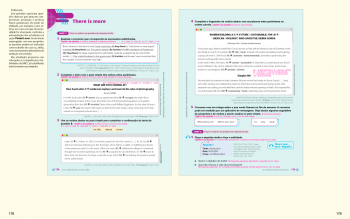
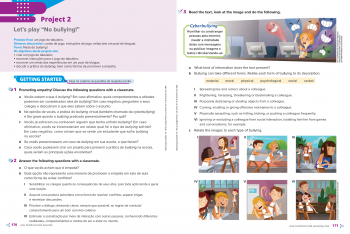
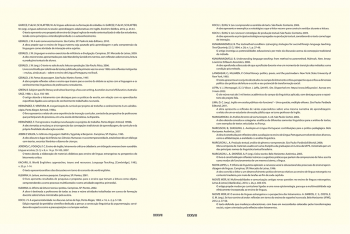
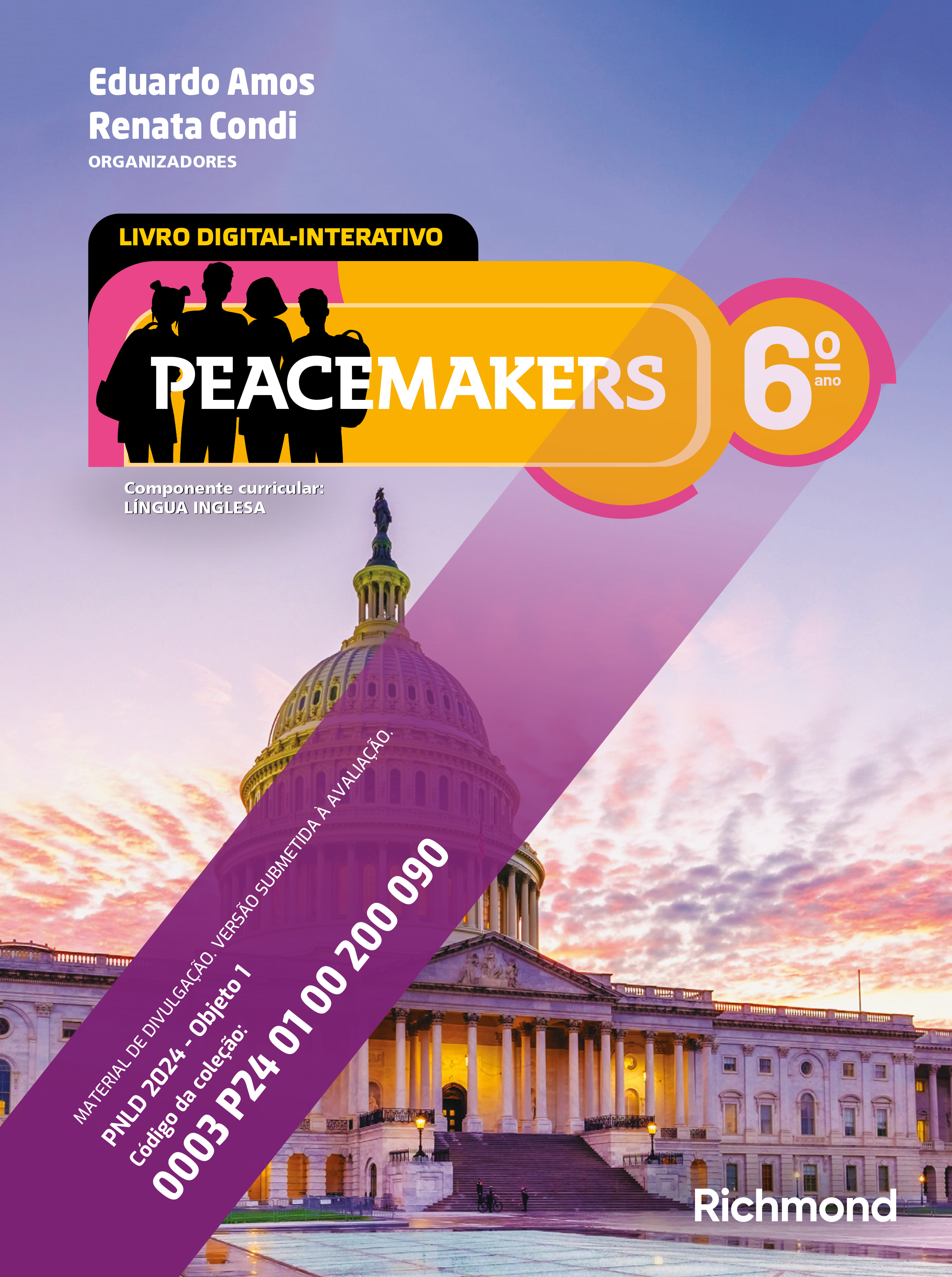

Compartilhar: